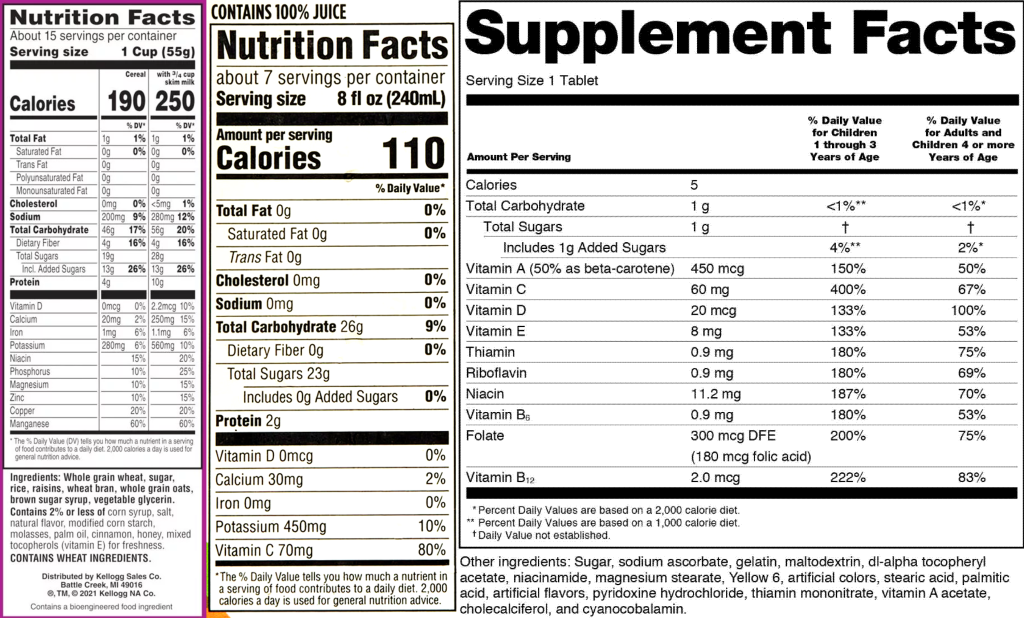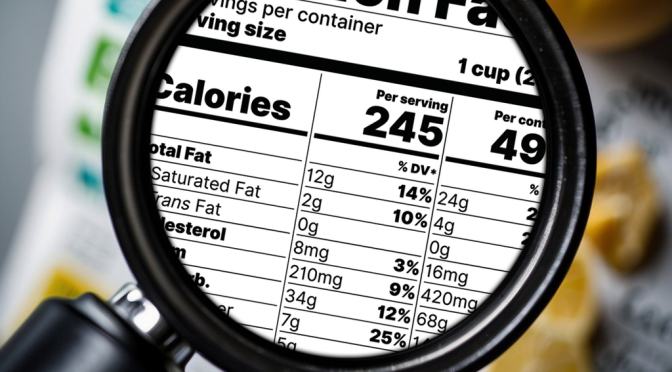Understanding the nutrition facts label on packaged foods is crucial. It helps people make informed dietary choices. The Food and Drug Administration (FDA) mandates these labels in the United States. They provide essential nutrition information to help you maintain a healthy diet. The label includes data on calorie content, serving size, and nutrients such as fats, sodium, fiber, and sugars. This empowers you to compare food items and select healthier options in line with the latest nutrition research.

They have implemented significant updates to nutrition facts labels. They reflect new scientific information and help you make better choices. For instance, the new nutrition facts label features changes. They include a more prominent display of calories and have updated the single serving sizes to better match how much people actually eat. They also now include added sugars. This helps you understand the makeup of the sugars you consume. These updates stem from evidence-based research and are part of ongoing efforts to improve public health.
The FDA provides a range of nutrition education resources and materials. The nutrition facts are designed to help you understand how to use them to your advantage. These resources include a comprehensive nutrition facts label guide. It can help you decipher the information presented. This ensures you have the knowledge needed to make choices that align with a nutritious and balanced diet.
Decoding the Nutrition Fact Label
Understanding how to read a Nutrition Facts label is essential. This skill helps you make healthier food choices and manage your daily diet.
The Importance of Reading Nutrition Fact Labels
The Nutrition Facts label on your food package is your guide to making informed choices that contribute to a healthy lifestyle. It provides detailed information about the nutritional content of the food. This helps you manage your calorie intake and maintain a balanced diet.
- Serving Size: Begin by looking at the serving size and the number of servings per package. Standardizing serving sizes makes it easier to compare similar foods; however, this may not reflect your usual portion size.
The number of calories listed is based on the provided serving size. It is crucial to monitor caloric intake, as consuming too many calories per day is linked to obesity and other health issues.
- Percent Daily Value (%DV): This tells you how much a nutrient in a serving of food contributes to a daily diet. Use %DV to determine if a serving of food is high or low in a nutrient.
| Nutrient | High %DV | Low %DV |
|---|---|---|
| Fat | 20% or more | 5% or less |
| Sodium | 20% or more | 5% or less |
- Daily Value (DV): DVs are reference amounts of nutrients to consume or not to exceed each day. Based on your caloric needs, you may need to adjust them from a 2,000-calorie diet.
- Nutrients: Aim to get less of saturated fat, trans fat, sodium, and added sugars. Look for foods with more dietary fiber, vitamin D, calcium, iron, and potassium to contribute to a healthy diet.
Interactive tools and updated Nutrition Facts labels have made it even more accessible to discern what’s in your food. They support healthy eating habits, while your choices at the grocery store can have a significant impact on your overall health and well-being.
Diving into Different Nutrition Labels

Navigating the various nutrition labels can help you make informed choices about the foods and beverages you consume. Here’s an overview of the different types of labels you’ll encounter on packaging.
Traditional Nutrition Facts Label
The Traditional Nutrition Facts Label has been a familiar feature on food packages. This label provides essential information on serving size, calories, and nutrient content. An important section to note is the breakdown of fats, carbohydrates, proteins, and vitamins per serving. It often helps you track your daily intake. Labels also list Percent Daily Values (%DV) based on a 2,000-calorie diet. This guides you in understanding the nutrient contribution of a particular food item to your overall diet.
New Nutrition Facts Label
In contrast, the New Nutrition Facts Label represents a major update. It’s designed to reflect new scientific findings and improve consumer understanding. With a refreshed design, you’ll notice that calories now appear in a larger, bold font. This makes it easier for you to quickly identify the caloric content. There’s also a new addition highlighting added sugars in both grams and %DV, helping you manage sugar consumption. The label features an updated footnote explaining the %DV more clearly. It guides you on the path to a balanced diet appropriate to your daily calorie needs.
Organic and Natural Food Labels
Organic and Natural Food Labels are not standard nutrition facts. They often appear on packages, indicating the product’s farming and processing standards. Food producers who use organic labels do not use synthetic pesticides. It was also produced without genetically modified organisms (GMOs). Natural labels are less regulated but suggest minimal processing. While these labels don’t provide nutrient information, they can align with your preferences on food quality and production ethics.
Supplement Facts Label
Supplements, such as vitamins and minerals, carry a Supplement Facts Label. They are different from conventional food products. Food nutrition labels have a similar formatting to this label. It offers details on serving size and nutrient content. However, it emphasizes dietary ingredients rather than daily meal contribution. Here, you’ll find specifics on the quantity of each nutrient per serving and its percent daily value. This information is crucial for aligning with your nutritional supplementation strategies.
Remember to review these labels carefully. Understand the nutritional value of what you’re adding to your cart. Ensure it aligns with your health goals and dietary requirements.
Essential Components of Nutrition Fact Labels

Nutrition fact labels serve as your guide to understanding the nutritional value of the foods you consume. Mandatory labels contain several sections. They detail the nutrients found in food items. This helps you make better dietary choices.
Serving Size & Servings Per Container
Serving Size: This specifies the amount customarily consumed and is critical to interpreting all the other data on the label. Remember, all nutrition information provided is in the context of this serving size.
Servings Per Container: Indicates how many servings are in the whole package. Comparing the serving size to the amount you consume can affect your intake of calories and nutrients.
Calories & Calories From Fat
Calories: Give you a measure of the amount of energy you get from a serving of the food. Consuming too many calories per day can contribute to weight gain.
Calories From Fat: Previously included on nutrition labels, this number showed how many calories in a serving come from fat. However, researchers have shown that the type of fat is more important than the amount, and manufacturers may not include this component on more recent labels.
Total Fat, Saturated Fat, Trans Fat, Cholesterol & Sodium
Total Fat: The sum of all fats present, which includes saturated, trans, and unsaturated fats.
- Saturated Fat: High intake can raise “bad” LDL cholesterol and increase the risk of heart disease.
- Trans Fat: You should keep them at a minimum or eliminate them entirely from your diet as they can increase “bad” LDL cholesterol and decrease “good” HDL cholesterol.
Cholesterol & Sodium: Monitoring intake of these is important as high levels can lead to high blood pressure and heart disease.
Total Carbohydrate, Dietary Fiber, Sugars & Protein
Total Carbohydrate: Broken down on the label to show fibers and sugars, carbohydrates are your body’s primary energy source.
- Dietary Fiber: Helps with digestion and can help prevent heart disease.
- Sugars: Includes both added sugars and those occurring naturally in foods.
Protein: Provides essential amino acids that the body cannot produce and is vital for muscle and tissue repair.
Vitamins & Minerals
The list informs you of your food’s contribution to your daily nutritional needs. It includes key vitamins and minerals, such as Vitamin D, Calcium, Iron, and Potassium.
- Vitamin D is crucial for bone health.
- Calcium helps in maintaining healthy teeth and bones.
- Iron is necessary for blood oxygenation.
- Potassium can help mitigate the adverse effects of high sodium intake.
Other Ingredients
This part typically includes a list of all substances contained in the food product. It includes preservatives, colorings, and additives. Reading this section can help you avoid ingredients that may be harmful to your health or to which you may have allergies.
(%DV) Your Key to Nutrition Labels
When you look at a nutrition facts label, % Daily Value (%DV) is a tool. It helps you understand the nutrient content of a food item in the context of your total daily diet. The %DV calculates and provides general nutrition advice based on daily value (DV) recommendations for key nutrients.
Understanding %DV:
- The nutrition facts label in the %DV column shows the portion of the recommended daily intake for each nutrient provided in a serving of the food.
- 5% DV or less of a serving is considered low if it has 5% DV or less of a nutrient, while it is deemed high if it has 20% DV or more.
Nutrient Needs and Daily Value
- DVs are average levels of nutrients for a person eating 2,000 calories a day.
- Your individual nutrient needs may be higher or lower, influenced by factors like age, gender, and physical activity level.
Interpreting the Numbers for Balanced Diet:
- Use the %DV to compare food products and to manage nutrients that you want to consume more or less of.
- The %DV helps you gauge the nutritional contribution of a food product to your diet, making it easier to stick to health recommendations.
For Nutrient-Specific Advice:
- Keep in mind that you should keep the %DV low for nutrients like trans fat, sodium, and sugars. You should meet or even exceed nutrients like dietary fiber, vitamin D, and calcium.
Remember, %DV provides a quick snapshot of a food’s nutritional profile. It helps you make informed decisions aligned with your dietary goals. Use it to choose foods that contribute to a healthy diet. Be mindful that personal nutrient needs vary with your physical activity level and other health considerations.
Nutrition Fact Labels: Frequently Asked Questions
Q: How do you read a Nutrition Facts label?
A: Reading a Nutrition Facts label is important for making informed food choices. Start by checking the serving size and number of servings per container. Then, look at the calories, and the amounts of fat, cholesterol, sodium, carbohydrates, fiber, sugars, and protein. Pay attention to the % Daily Value, aiming for lower values of fat, cholesterol, and sodium, and higher values of fiber, vitamins, and minerals. Lastly, consider the ingredients list to be aware of any additives or allergens.
Q: How do you interpret data from food labels?
A: Interpreting data from food labels involves understanding the serving size and the corresponding nutrient amounts. Pay attention to the % Daily Value, which indicates how much of a specific nutrient one serving provides based on a 2,000-calorie diet. Aim for lower % Daily Values of saturated fat, trans fat, cholesterol, and sodium, and higher % Daily Values of fiber, vitamins, and minerals. Remember that the % Daily Value is based on a general guideline, so individual nutrient needs may vary.
Q: What is the 5 20 rule when discussing the nutrition fact label?
A: The 5-20 rule is a simple guideline to help interpret the % Daily Value on a nutrition label. It suggests that a % Daily Value of 5% or less for a nutrient is considered low, while a % Daily Value of 20% or more is considered high. This rule can be used to quickly identify whether a food is low or high in a specific nutrient. For example, aiming for foods with a % Daily Value of 5% or less for fat and aiming for foods with a % Daily Value of 20% or more for fiber.
Q: What are the 7 important details contained on a label?
A: The seven important details contained on a food label are the serving size, calories, nutrients (such as fat, cholesterol, sodium, carbohydrates, fiber, sugars, and protein), % Daily Value, the list of ingredients, allergen information, and any additional health claims or information provided by the manufacturer. These details can help you make informed decisions about the nutritional content of the food product and its potential impact on your health.
Q: What ingredients should be avoided in food labels?
A: When reading food labels, it’s important to be cautious of ingredients such as artificial trans fats, high-fructose corn syrup, artificial sweeteners, artificial colors and flavors, preservatives like BHA and BHT, and excessive amounts of added sugars and sodium. These ingredients have been linked to various health concerns when consumed in large quantities. Opting for whole, minimally processed foods can help you avoid these potentially harmful ingredients and make healthier choices for your overall well-being.

